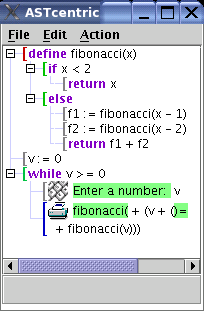
Study 1
In order to study some implications of a purely AST-centric IDE I wrote a prototype in Java (download it here).
 It is an IDE for a tiny procedural language which I called 'Simple'. Here are the main features of Simple:
It is an IDE for a tiny procedural language which I called 'Simple'. Here are the main features of Simple:
- Scalar variables: Types are integer, floating point number, boolean, and string. Not type-safe.
- Operators: '+', '-', '*', '/', '>', '>=', '<', '<=', '>', '>=', '=', '!='
- Functions with scalar result and arbitrary but fixed number of arguments.
- Assignment statement
- If, elseif, and else statements
- While statement
- Return statement
- Console output
- Console input
- Graphical non-textual visualization of the tree.
- Expanding/collapsing of tree nodes.
- Visualization mixes text (in different fonts and colors) and icons.
- Pretty line wrapping.
- Dynamic line wrapping: Statements will be wrapped around if the width of the window shrinks.
b
(
f:1.fibonacci:x
(
i:LT:v-1:L2
(
r:v-2
)
e
(
a:f1:f-3.1:1:SUB:v-3:L1
a:f2:f-4.1:1:SUB:v-4:L2
r:ADD:v-2:v-1
)
)
a:v:I0
w:GE:v-1:I0
(
t:-2:"Enter a number: "
p:ADD:"fibonacci(":ADD:v-3:ADD:")=":f-4.1:1:v-3
)
)
(C) 2005-2007 Franz-Josef Elmer. All rights reserved. Last modified: 5/6/2007